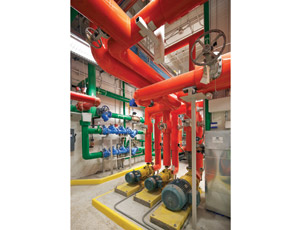Duke University’s $21-million East Campus Steam Plant is in an architecturally significant, historic building that was one of the original campus structures designed by the architectural firm of Horace Trumbauer.


The building was constructed at a cost of $440,000 during the unsteady financial times of the late 1920s. It sat unheated after being decommissioned about 30 years ago.
The steam plant includes architectural features and touches uncommon for an industrial building. Cornices, decorative brickwork and recessed brick medallions with brick around inset square concrete panels resembled details of tobacco factories and warehouses.
By carefully working to preserve, update and maintain the structural and architectural integrity of the facility, Balfour Beatty Construction of Charlotte was able to restore this important building to its former glory. Initially intended to involve just the replacement of the boilers, the scope of the 7,500-sq-ft renovation evolved over time and is now viewed as the beginning of Duke’s extensive central campus renovation.
Work began in January 2008 and entailed re-mortaring of nearly the entire building and an extensive effort to waterproof a large portion of the structure, which was located topographically at the lowest point in the area.
In conjunction with the attached steam tunnel, workers created a watershed pooling point against the building’s north wall. Foundation waterproofing was not used in the original construction, and over the years, the subterranean walls became porous, allowing water to pour into the basement due to the hydrostatic pressure created by the damming effect of the building’s footprint.
The hydrostatic pressure was adequate to make the original boiler fire pits that penetrated the lower floor pad act like artesian wells once the boilers were removed.
The team used H piles and wood lagging installed about 15 ft from the wall to allow a miniexcavator to dig from inside the excavation, without disturbing the surrounding area or the trees. Once the soil was removed, the exposed footer and foundation walls were cleaned in preparation for the application of the waterproofing liquid membrane coating.
Crews dismantled three massive brick boilers brick-by-brick, a process that took three months, and renovated the existing structure to accommodate 15 new natural gas-powered 10,000-lb boilers. The installation is thought to be the largest of its kind in the United States. The system allows Duke to reduce its coal use by 70% while providing 35% more steam, enough each hour to heat 2,500 houses.
The team reused 87% of the original building, including all of the brick; installed high-efficiency glazing and low-flow fixtures; and recycled construction waste. Balfour Beatty completed the project in January. The plant runs in an automatic mode and is virtually unmanned with the exception of system maintenance and repair.
Key Players
Owner: Duke University
Contractor: Balfour Beatty Construction
Architect: Smith Group
Engineer: RMF Engineering


Post a comment to this article
Report Abusive Comment